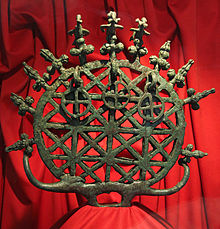
Back Bronstydperk Afrikaans Bronzezeit ALS ናስ ዘመን Amharic Edat de Bronce AN कांस्य युग ANP العصر البرونزي Arabic عصر برونزى ARZ ব্ৰঞ্জ যুগ Assamese Edá del bronce AST Tunc dövrü Azerbaijani
This article may require copy editing for grammar, style, cohesion, tone, or spelling. (January 2024) |

| Bronze Age |
|---|
| ↑ Chalcolithic |
| ↓ Iron Age |
| History of technology |
|---|
The Bronze Age is a historic period, lasting from approximately 3300 BC to 1200 BC. It is characterized by the use of bronze, the use of writing in some areas, and other features of early urban civilization. The Bronze Age is the second principal period of the three-age system proposed in 1836 by Christian Jürgensen Thomsen for classifying and studying ancient societies and history. It is also considered the second phase of three, in the Metal Ages.[1]
An ancient civilization is deemed to be part of the Bronze Age if it either produced bronze by smelting its own copper and alloying it with tin, arsenic, or other metals, or traded other items for bronze from producing areas elsewhere. Bronze is harder and more durable than other metals available at the time, allowing Bronze Age civilizations to gain a technological advantage.
While terrestrial iron is naturally abundant, the higher temperature required for smelting, 1,250 °C (2,280 °F), in addition to the greater difficulty of working with the metal, placed it out of reach of common use until the end of the second millennium BC. Tin's lower melting point of 231.93 °C (449.47 °F) and copper's relatively moderate melting point of 1,085 °C (1,985 °F) placed both these metals within the capabilities of Neolithic pottery kilns, which date back to 6,000 BC and were able to produce temperatures of at least 900 °C (1,650 °F).[2] Copper and tin ores are rare since there were no tin bronzes in West Asia before trading in bronze began in the 3rd millennium BC. Worldwide, the Bronze Age generally followed the Neolithic period, with the Chalcolithic serving as a transition.
Bronze Age cultures were the first to develop writing. According to archaeological evidence, cultures in Mesopotamia, which used cuneiform script, and Egypt, which used hieroglyphs, developed the earliest practical writing systems.
The Bronze Age is said to have ended with the Late Bronze Age collapse, a time of widespread societal collapse during the 12th century BC, mostly between c. 1200 and 1150. This collapse affected a large area of the Eastern Mediterranean, including North Africa and Southeast Europe, as well as the Near East, in particular Egypt, eastern Libya, the Balkans, the Aegean, Anatolia, and the Caucasus. It was sudden, violent, and culturally disruptive for many Bronze Age civilizations, and it brought a sharp economic decline to regional powers, most notably ushering in the Greek Dark Ages.
- ^ The Metal Ages. Encyclopedia Britannica.
- ^ III, James E. McClellan; Dorn, Harold (14 April 2006). Science and Technology in World History (2nd ed.). Baltimore, MD: JHU Press. p. 21. ISBN 978-0-8018-8360-6.